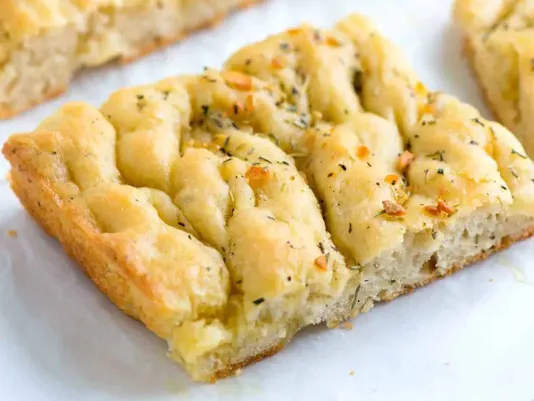Focaccia and Tomato Gratin
Focaccia and tomato gratin is an Italian recipe, if you don't stock up on focaccia, you can use white bread.

Focaccia belongs to those breads that have the character and structure to withstand various culinary interpretations. Over the years of working with this product, I’ve learned to sense its density and moisture even by touch. Good focaccia should be elastic but not sticky; its crumb – porous, with no signs of underbaking. This texture makes it ideal as an ingredient in dishes: for sandwiches, appetizer bases, salad elements, or even as an absorbent for flavorful sauces. Each type of focaccia has its own specificity: with rosemary – savory, with olives – meatier in taste, with onion – slightly sweet. It combines aromas and textures, forming a bridge between complex dishes. I value it for its ability to remain distinctive even within a layered ensemble.
When I select focaccia as an ingredient, I always consider its texture, moisture, and type of seasoning. For hot appetizers, I prefer focaccia with a denser crumb – it holds its shape even when used as a base for a tart or baked sandwich. For salads, I use softer, slightly moist focaccia, which can be cut into cubes and lightly toasted – it becomes excellent croutons that retain their aroma even in dressing. If I plan to serve focaccia with meats or cheeses, I choose a version with minimal spices: such a bread base doesn’t overpower the flavor of the main ingredients. It’s important to pay attention to the crust color – too dark means overbaked dough, and such focaccia quickly loses texture after slicing. I also always check the aroma: quality focaccia smells of olive oil, herbs, and wheat, but not yeast. This nuance is often ignored, yet it determines how the bread will behave in a dish. Good focaccia never leaves a greasy aftertaste, only a delicate crispness and a subtle finish.
Before incorporating focaccia into a dish, I always assess its moisture and temperature. If the bread has just been baked, it needs to rest at room temperature for at least an hour – hot focaccia can soften other components and upset the texture balance. For salads or cold appetizers, I dry the pieces at low heat until they become light but not brittle. If serving hot, I lightly drizzle the surface with oil so that the aroma revives when heated. In my practice, I often combine focaccia with moist ingredients, so I always ensure it doesn’t absorb excess liquid – an overly soft crumb makes the dish untidy. To prevent this, I use brief toasting or baking: this creates a thin film that preserves structure. Sometimes I add focaccia to sauces as a thickener or flavor carrier – in that case, I grind it into fine, pre-dried crumbs. All this allows me to maintain control over consistency, which is essential for a professional approach to bread-based ingredients.
Focaccia responds well to reheating if done moderately. The optimal temperature for reheating is 180°C (356°F): at this point, the crust becomes crisp again, while the crumb stays moist. If the temperature is higher, the oil begins to smoke, and the herb aroma turns bitter. In hot dishes, I’m always careful: if focaccia comes into contact with sauce or juices, it should be added at the end to preserve its shape. For toasting, it’s best to use a rack rather than a solid tray – this allows steam to escape and keeps the bread light. In cold dishes, the texture should remain elastic: overly dry focaccia breaks and won’t hold the filling. I often use a quick dry-pan sear – it revives the aroma and activates surface oils without added fat. I also check internal moisture by cutting a piece in half: if it’s springy rather than crumbly, the temperature was correct. Over the years, I’ve realized that texture control isn’t just about appearance, but a precise balance between softness and structure.
Focaccia has a naturally bready flavor that pairs beautifully with many ingredients. In my experience, it often serves as a neutral bridge between rich flavors: aged cheeses, tomatoes, cured meats, roasted vegetables. With fish, I choose focaccia without rosemary – its clean aroma enhances the delicacy of salmon or tuna. For salads like panzanella, it’s better to use dried, almost crunchy focaccia – it absorbs vinegar and oil well without turning mushy. If the dish is based on a creamy sauce, I add focaccia in toasted chunks – they hold the sauce on the surface without breaking apart. This bread stands up well to contrast: sour, spicy, salty, and rich components work together to create a balanced flavor profile. I rarely use focaccia in desserts, but sometimes as a base for caramelized fruits – its neutrality highlights sweetness without excess. This versatility makes it a true culinary tool, not just a piece of bread.
I always advise treating focaccia not just as a side but as a full-fledged ingredient that requires attention. The most common mistake is using stale focaccia without restoring its texture: such bread absorbs oil poorly and creates a dry impression. If focaccia is a day or two old, I always refresh it in the oven or over steam to restore elasticity. The second problem is too much salt or seasoning: they can clash with the dish, especially when anchovies or pickled ingredients are involved. Another typical mistake is improper storage. Focaccia doesn’t like the refrigerator: the cold destroys its structure, making the crumb rubbery. I store it in a paper bag at room temperature, and for longer storage, I freeze it wrapped in plastic. This way, it retains its aroma and shape. Over years of experience, I’ve learned that controlling the quality of bread components often determines the success of the entire dish. Good focaccia isn’t just baked bread but a stable foundation on which any culinary idea can rest.